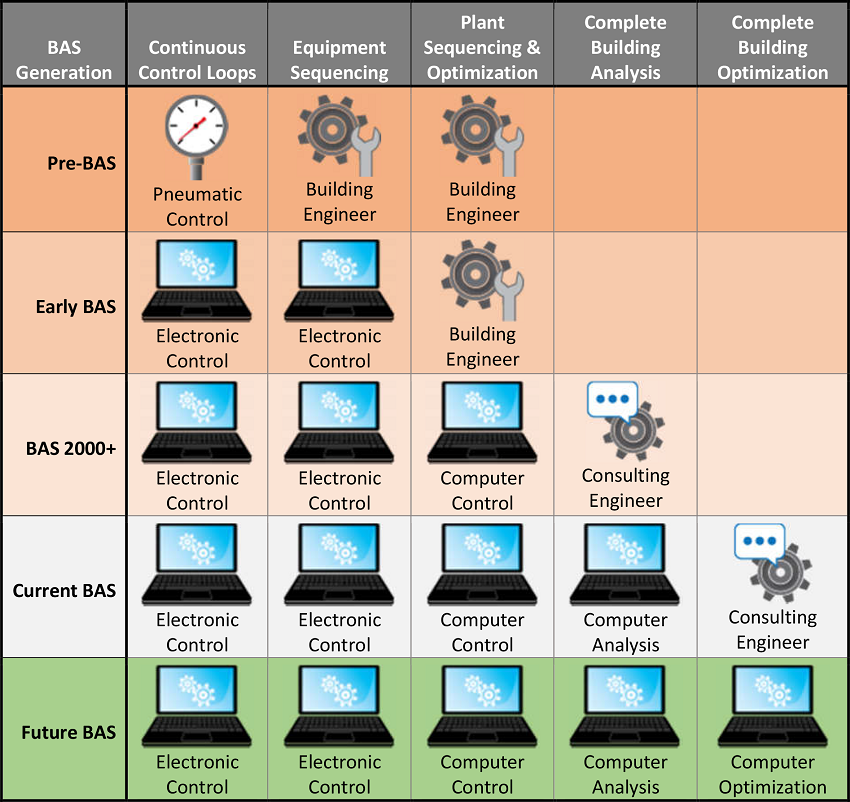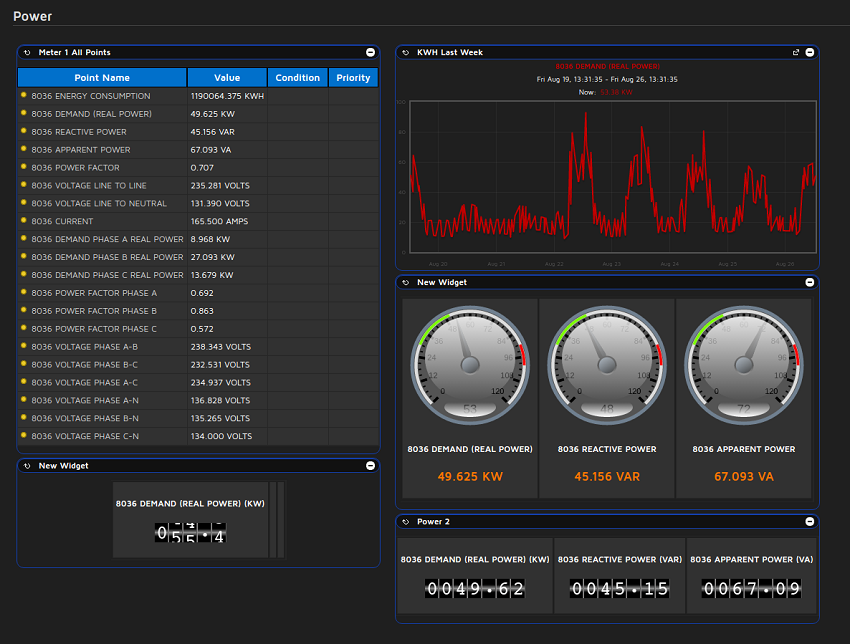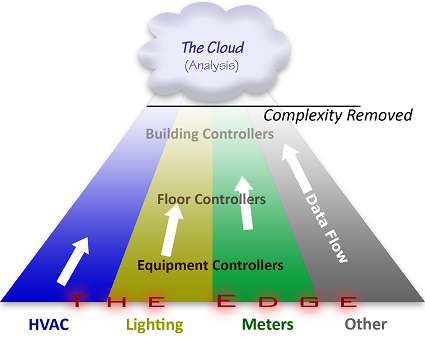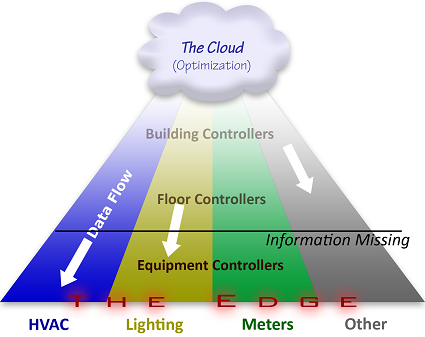|
September 2016
Article
AutomatedBuildings.com
|
[an error occurred while processing this directive]
(Click
Message to Learn More)
|
Distributed Analysis and
Optimization in
Building Automation
Complete system
optimization will require the full complexity of
existing building systems, and will be best achieved by the BAS
manufacturers themselves. We look forward to
these exciting changes on the horizon.
|

Mike Donlon,
Director of Research and Development,
Computrols
|
Roadmap to Complete
Building Optimization
Recent advances in Machine Learning and Artificial
Intelligence are steadily making their way across diverse industries
and products. From speech recognition, to financial analysis and
weather prediction, these new computer technologies leverage big data
to recognize patterns, build mathematical models and make predictions.
Building automation systems are not exempt from this technological
revolution. Large buildings and automation systems, rich with big data,
controllers, networks and computers, are poised to take full advantage
of these new technologies.
Today, many companies are beginning to use these new
technologies for analysis, but analysis is only half of the picture.
Our ultimate goal in building automation systems (BAS) is Complete
Building Optimization. That is, we want to take all of the
equipment and information that exists today, analyze it, then operate
the building in a way that minimizes energy consumption and maximizes
tenant comfort and equipment life spans. This is not a matter of if it
will happen, but when. If we look at the evolution of BAS over the past
few decades, we see a continuous trend of more automation, more
efficient operation and less labor. The simple illustration below helps
us visualize this trend:

Although
this illustration shows complete computer control as the future, this
isn’t to suggest that the building staff won’t be involved. Like most
technological advancements, job descriptions will shift as automation
progresses. Management, planning, service, installation, etc. will
still be performed by building staff. What will be completely
computer-driven will be the tedious calculations and analysis that are
required in building optimization. Still, computer optimization will be
overseen by people, and the end result will be a valuable tool for
building managers and engineers.
However,
the road to true building optimization is not so clear. As we know from
experience, technological advancement in building automation can be
slow and cumbersome. Standards and protocols can be debated, delayed or
rejected. This article intends to highlight some of the potential
challenges and pitfalls along the road to complete building
optimization, as well as suggest some approaches and solutions that we
hope will be useful.
Rise
of the Energy Dashboards
HVAC,
Lighting, Fire and other building systems continue to grow in point
count and complexity as the cost of automation drops and technology
advances. Even Elevator Systems are becoming more complex with the
advent of technologies like Destination Dispatch. Unfortunately, all of
this increased complexity leaves building owners, managers and
engineers overwhelmed with information.
BAS
vendors have generally failed to manage this complexity in a way that
makes it easy for building engineers and managers. Systems are riddled
with different software programs and tools, cryptic user interfaces,
and workarounds. Building staff has to rely heavily on service while
still not completely understanding their systems. When combined with
the pressure for ever-increasing energy efficiency, measurement and
reporting, many building managers are in a difficult situation. It’s
clear that classic BAS systems are doing a poor job assisting building
owners and managers with a simplified, big picture of their building,
especially concerning overall energy usage and efficiency.
Seeing
this opportunity, dozens of small Internet and mobile-savvy startups
have sprung up to fill this void. Collecting data from disparate
systems and integrating data into clean, modern user interfaces, this
new wave of integration products assist building owners and managers in
their quest for simplicity. Often referred to as Smart Building Platforms, these
systems regularly use web and mobile friendly dashboards and graphs.

Computrols Real-Time Energy Dashboard
Ideally,
the addition of these new systems is a valuable tool for building
engineers and managers. In other cases, new systems further complicate
existing problems. How does this new system integrate to existing
systems? Who is responsible if the displayed data is incorrect? How
much control is given to these systems and taken away from other
systems? These are all issues that building managers need to consider
when shopping for one of these systems.
Usable
Analysis in Large Buildings is Difficult
Although
there is some limited value in simply visualizing building data, the
true intended use of Smart Building Platforms is to perform analysis
and highlight problems in the building. The extent to which valuable
analysis is presented varies from product to product. Certainly, a
cursory scan of building data can reveal common problems, like running
equipment or lights outside of scheduled hours. Realistically,
buildings should not add to the complexity and cost of a separate
system to identify simple problems.
A
deeper analysis of building data might reveal more elusive problems. In
HVAC systems, a building may be using suboptimal setpoints or
suffer from restricted flow of air or water. The problem with analysis
performed outside of any complex system with limited detail is that
perceived problems may be nonissues. Engineers and technicians with a
more intimate knowledge of the system may already know about
highlighted issues, and living with an issue may have already been
chosen as the lesser of two evils.
Take
for example supply air setback. Recommending changes in setpoints are a
staple for analytics programs. Initial analysis often indicates that
raising supply air and other setpoints would reduce plant energy while
still meeting all temperature requirements. Setpoints are low hanging
fruit for HVAC analytics. However, did the analysis consider how
raising the setpoint would affect humidity?
Most
building engineers know that humidity problems can be challenging. They
not only cause tenant discomfort, but potential property damage. In
medical facilities, along with temperature and pressure, compliance
requires that humidity is continually measured and reported on. Failure
to comply can be very costly—often much more costly than potential
energy savings. Recommendations—even those as simple as changes to HVAC
setpoints—require a deep understanding of the mechanical system and
operating requirements.
As
shown in our illustration above, the current state-of-the-art for
building automation is for automated analytics to make recommendations
only. Recommendations should be followed by careful consideration by
experts before action is taken. But even then, actions taken will often
require service from individual system vendors themselves as control
logic is reworked. Basically, real analysis that produces actionable
intelligence is usually more difficult than it is described.
And
Analysis is Only Half the Picture…
As
stated above, many industries and systems are benefiting from the new technological advances in machine learning and AI.
However, building automation is significantly different from most of
these systems and therefore must be handled differently. As an example,
let’s consider weather prediction.
Like
in buildings, weather data includes temperature, pressure, and
humidity, as well as quantities like wind speed. These quantities are
collected at thousands of locations worldwide. Like in buildings, this
data is continually stored over time, and meteorologists leverage these
new technologies on their big data to model weather systems that
ultimately provide weather predictions.
But what meteorologists don’t do is turn
around and try to control the weather.
Weather
data is input only. There are no outputs. It is only analysis—not
automation and optimization.
In
building automation, we also want to analyze, model and make
predictions from building data. But unlike these other systems, our
ultimate goal is to use this analysis to control our facilities
automatically and optimally whenever possible.
The
problem is that current analytics software aggregates complex building
data into simpler, bite-sized chunks. For big picture analytics, we
want to remove “undesired” complexity. For optimization, we need to
propagate a complete optimum strategy back into these individual
systems. All of the data we removed during analysis will be missed if
the intent is to use analysis for optimal control. This is illustrated
below:


Lesson Learned: Distributed Control
Early building automation systems from the 1980’s used a
Master/Slave
approach to control. In these early systems, all of the “smarts” were
centralized in a single large
computer. The field controllers themselves were “dumb” and would
rarely make decisions on their own. At
the time, this was the only way to achieve automation. Electronics were
not yet cheap and powerful
enough to perform distributed control, and automation software had not
yet evolved to the point where
control problems could be broken up and distributed throughout the
building.
This changed in the 1990’s when revolutionary Direct
Digital Control
(DDC)systems began to take over. As an industry, we learned that
distributing the “smarts” as close to
equipment, sensors and actuators was the only way to achieve high
reliability and management. It’s not
simply that DDC systems are only more tolerant of network failures, but
more importantly it allows
equipment and controller manufactures to encapsulate complex details
within a controller and
expose only the data that is required by other systems. This way,
networks of disparate systems can
be more easily managed, and manufacturers develop faster and more
freely. They don’t have to
explain or export internal complexity to the larger system.
Future Solution: Distributed Analysis and
Optimization
[an error occurred while processing this directive]We are at the early stages of performing complete
building analytics
and optimization, and today’s analytics systems use a single,
cloud-based computing for all analysis.
They use large clusters of computers to run analytics in batch. It is
common for consultants to
spend weeks to months collecting data, then several more weeks or
months to analyze and submit results.
As we learned with automation and control in early BAS
systems, a
single Master computer collecting data from many sources is not the
best way to perform analysis and
optimization. So why is this the preferred method today? Simply, it
is the only way that current
technology allows us to do it.
But as technology progresses, it will become more and
more feasible to
run machine learning algorithms in a distributed way directly on
equipment controllers. Tiny embedded
computer systems are becoming commonplace, and open source algorithms
are also becoming more common.
This will allow individual equipment and controller manufacturers
to not only embed analytics
directly into their controllers, but also perform optimization
continuously—even when the Internet or
networks are unavailable.
Conclusion: Machine Learning at the Edge
Today, it’s hard to imagine a control system that is not
DDC. As
automation progressed in the 90’s, we expect the same progression for
analytics and optimization today and
tomorrow. Individual controllers and systems in buildings will perform
their own analytics and
optimization, encapsulating complex details while feeding results up to
larger systems. This trend will not
only prove to be the more reliable solution, but also allow more rapid
development and easier management.
In order to accomplish this, BAS manufactures need to do
a better job
of incorporating this new technology into their products. It is no
longer enough to simply
control equipment in a suboptimal way and treat energy usage as an
afterthought.
Building-wide add-on software packages will always have
their place.
Centralized graphics can be a great convenience, and a redundant audit
of other systems can be useful.
However, true optimization will not be easily achieved without the
cooperation of large building systems
like HVAC and Lighting. Today’s chiller plant optimization programs are
a testament to the power
specialized system optimization. Complete system optimization will
require the full complexity of
existing building systems, and will be best achieved by the BAS
manufacturers themselves. We look forward to
these exciting changes on the horizon.
About the Author
Mike Donlon is the Director of Research and Development and one of the
owners of Computrols. He received his Bachelor’s Degree in Electrical
Engineering from the University of New Orleans in 1986. He returned to
UNO to get his Master’s Degree in Engineering and focused his studies
on computer vision and image processing. While in graduate school, he
was employed as a research assistant at Kresge Hearing Institute of the
LSU Medical Center. In 1989 he was hired by Computrols as the principle
software developer for the original CBAS computer system. Soon
afterward he was invited by the company’s originators to become an
equity partner. Since then his duties have been to oversee all software
and hardware development for the company as well as researching and
applying new technologies to Building Automation. His recent areas of
interest include machine learning, building system modelling and open
source technologies for building automation. He can be contacted at: mike.donlon@computrols.com
footer
[an error occurred while processing this directive]
[Click Banner To Learn More]
[Home Page] [The
Automator] [About] [Subscribe
] [Contact
Us]



